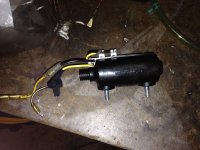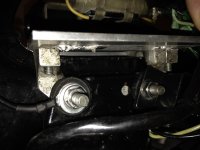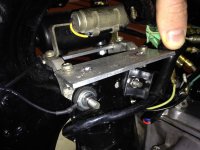cgguy09
1971 CB350 K3
Hey Road Warriors,
So this is a coil, condenser question. I'll begin with this: Compression is at 170 on Each cylinder, the valve gap is in-check (finally), point gap is good, brand new spark plugs, new coil wires, brand new coils, timed to a tee, brand new points, fully charged battery, full tank of gas, recent blood sacrifice to the gods.
I am getting no, or somewhat irratic, combustion on one cylinder. However, when I switch all the wires around the previously faulty cylinder runs perfect. Thus the problem is electric.
In examining the coils/plugs/wires....When I turn the bike over (electrically) I get what appears to be blue bright sparks on both plugs. I have both plugs sparking just as I pass "LF" or "F". I have switched the wires & the plugs (independent of each other) with no differentiating results.
So I am left with the coils or the condenser....
The coils are brand new. I mean BRAND new. I ordered them from DCC. That being said, of the two I originally purchased I returned one because it shorted out. The good folks at DCC sent a replacement no Q's asked. Now, the other one I originally got is the potential "problem." Could these coils just have been a bad batch? Seems odd? Could there be some gremlin on my bike that eats the inside of coils while I sleep?
I am also left thinking the condenser could be to blame. Is it possible the condenser would allow one coil to properly operate and the other to not? (I also recognize that the condenser is actually two condensers, so this seems wholly possible thanks to AlphaDog in a prior post http://www.dotheton.com/forum/index.php?topic=46811.0 )
I saw some witch craft test where you hook it up to a resistor and a battery...I am probably not going to do that. What I propose to do is isolate the condenser through just swapping the blue and yellow wires & keep everything else the same. Would this cause any potential problems? I'll avoid placing my logic for why it wouldn't. I would actually test it now, but it's 1100 & my neighbors would like to sleep.
Thanks guys, as always. Your advice, love, & attention are appreciated.
cFogs
BT
NNNN
So this is a coil, condenser question. I'll begin with this: Compression is at 170 on Each cylinder, the valve gap is in-check (finally), point gap is good, brand new spark plugs, new coil wires, brand new coils, timed to a tee, brand new points, fully charged battery, full tank of gas, recent blood sacrifice to the gods.
I am getting no, or somewhat irratic, combustion on one cylinder. However, when I switch all the wires around the previously faulty cylinder runs perfect. Thus the problem is electric.
In examining the coils/plugs/wires....When I turn the bike over (electrically) I get what appears to be blue bright sparks on both plugs. I have both plugs sparking just as I pass "LF" or "F". I have switched the wires & the plugs (independent of each other) with no differentiating results.
So I am left with the coils or the condenser....
The coils are brand new. I mean BRAND new. I ordered them from DCC. That being said, of the two I originally purchased I returned one because it shorted out. The good folks at DCC sent a replacement no Q's asked. Now, the other one I originally got is the potential "problem." Could these coils just have been a bad batch? Seems odd? Could there be some gremlin on my bike that eats the inside of coils while I sleep?
I am also left thinking the condenser could be to blame. Is it possible the condenser would allow one coil to properly operate and the other to not? (I also recognize that the condenser is actually two condensers, so this seems wholly possible thanks to AlphaDog in a prior post http://www.dotheton.com/forum/index.php?topic=46811.0 )
I saw some witch craft test where you hook it up to a resistor and a battery...I am probably not going to do that. What I propose to do is isolate the condenser through just swapping the blue and yellow wires & keep everything else the same. Would this cause any potential problems? I'll avoid placing my logic for why it wouldn't. I would actually test it now, but it's 1100 & my neighbors would like to sleep.
Thanks guys, as always. Your advice, love, & attention are appreciated.
cFogs
BT
NNNN









